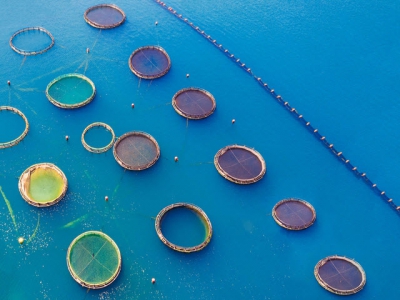Study: Climate change an increasing threat to aquaculture

NCEAS researchers urge mitigation, movement of operations as production expands
A new study warns coastal nations to expect their potential for aquaculture production to decline over time, as water temperatures increase and oceans undergo other shifts, such as acidification. Photo by Anton Watman, via Shutterstock.
California-based researchers are urging the global aquaculture industry to take proactive measures to protect global food security in the face of climate change.
Lead author Halley Froehlich, a postdoctoral researcher at the National Center for Ecological Analysis and Synthesis (NCEAS) at U.C. Santa Barbara, said the world’s fastest-growing food-production sector is already feeling the effects of climate change, which will only increase over time. Their latest report is out Monday, Sept. 10 in the journal Nature Ecology and Evolution.
“It’s likely to get worse for most of the world if we don’t take mitigating measures,” said Froehlich, urging governments to start long-term planning now. “There’s a lot of push for ‘blue growth’ in aquaculture in both developing and developed regions, but less effort has gone into how to develop adaptive measures under climate change, mostly because we do not have a good sense of the level or location of impacts. Our study begins to shed light on these unknowns.”
The study is the first comprehensive analysis of how climate change could affect marine aquaculture production around the world, specifically for finfish and bivalve shellfish. The analysis is geared to help ocean farmers and coastal nations prepare for change and to ensure sustainable seafood production. The authors say coastal nations should expect their potential for aquaculture production to decline over time, as water temperatures increase and oceans undergo other shifts, such as acidification.
The region that currently accounts for 90 percent of the world’s total aquaculture production – Indo-Pacific countries such as China, Bangladesh, and Indonesia – will likely feel the biggest impacts, the NCEAS team said. The shifting ocean conditions the authors looked at specifically were warming sea surface temperatures, ocean acidification and changes in algae, a primary food source for oysters and other bivalves.
“Governments provide permits and leases for growing different species and setting those locations now with the future in mind will help avoid putting things in riskier places,” said co-author Ben Halpern, director of NCEAS and a professor at UCSB. “If you were a land farmer, would you want to buy property that will be plagued by drought in 15 years? I doubt it. The same thinking should be applied to ocean farming.”
Without intervention, production by 2050 in finfish could decline by as much as 30 percent in some areas; a complete loss of suitable waters for bivalve cultivation is also a possibility. But in “winning” patches of ocean – such as sub-polar waters near Norway – aquaculture production could fare well or better under climate change.
“The issue is less about whether or not we will be able to grow enough fish in the ocean under a changing climate globally – we can – and instead about who wins and who loses, and by how much,” said Halpern. “Climate change will likely have highly inequitable consequences among ocean farmers.”
Froehlich noted that the strategy to help ocean farmers adapt will be to move or place farms in more favorable ocean places, a measure supported by the Food and Agriculture Organization of the United Nations (FAO).
“The industry is still in its growing phase, and that allows some flexibility,” said Froehlich, noting that salmon farmers in Australia are already relocating some ocean net pens, while U.S. oyster farmers are moving hatcheries away from acidified waters of the Pacific Northwest.
“Aquatic farmers are on the frontlines of climate change. Some are already seeing the effects and know they need to be prepared for what’s to come. But that’s going to take planning by not only the farmers, but governments too,” Froehlich said.
Related news
 The seafood companies push export turnover in the last months of the year
The seafood companies push export turnover in the last months of the year Despite the increase in export turnover in the first months of 2018, many seafood enterprises exporting seafood in Vietnam are overcoming the technical barriers
 Difficulties challenge aquaculture development in the north
Difficulties challenge aquaculture development in the north Despite its great potential, aquaculture development in Vietnam’s northern provinces is facing difficulties and challenges in terms of marketing
 Việt Nam has opportunity to boost white-leg shrimp exports to EU
Việt Nam has opportunity to boost white-leg shrimp exports to EU Việt Nam has many opportunities to increase white-leg shrimp exports to the European Union (EU) in the future